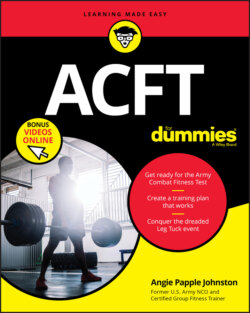Читать книгу ACFT For Dummies - Angela Papple Johnston - Страница 21
Aerobic exercise for cardiovascular endurance
ОглавлениеThe Army measures your aerobic fitness through its old standby, the Two-Mile Run. Though you’re unlikely to have to run for two miles in a combat situation (and you’re even more unlikely to have to do it in your PT uniform), you are likely to engage in aerobic exercise — cardio — on the battlefield. The Army needs to know you can hack it, and it figures out what your endurance is like by making you run. Getting a good picture of a soldier’s aerobic fitness takes about 12 minutes of continuous exercise, and most people take longer than that to cover two miles. (Personally, I’d rather the Army just made me run for 12 minutes to see how far I get, but so far, they haven’t been very receptive to the idea.)
Aerobic exercise requires your heart to pump oxygenated blood to your muscles. Your heart has to beat faster to keep up with your movement, and your body has to figure out how to balance itself out until you stop the exercise. Check out Table 1-1, which gives you a ballpark range for where your heart rate should be in beats per minute (bpm) during moderate and vigorous aerobic exercise. The American Heart Association doesn’t distinguish between ages 20 and 30 (that’s why you don’t see a row in the table for 25-year-olds) because people in that age bracket typically fall into the same heart rate zones. Chapter 8 shows you how to take your cardio fitness up a notch or two, so if that’s an area you need to improve, you can find suggestions there.
TABLE 1-1 Heart Rate Zones
| Age | Moderate Exercise | Vigorous Exercise |
|---|---|---|
| 20 | 100 to 170 bpm | 200 bpm |
| 30 | 95 to 162 bpm | 190 bpm |
| 35 | 93 to 157 bpm | 185 bpm |
| 40 | 90 to 153 bpm | 180 bpm |
| 45 | 88 to 149 bpm | 175 bpm |
| 50 | 85 to 145 bpm | 170 bpm |
| 55 | 83 to 140 bpm | 165 bpm |
| 60 | 80 to 136 bpm | 160 bpm |
